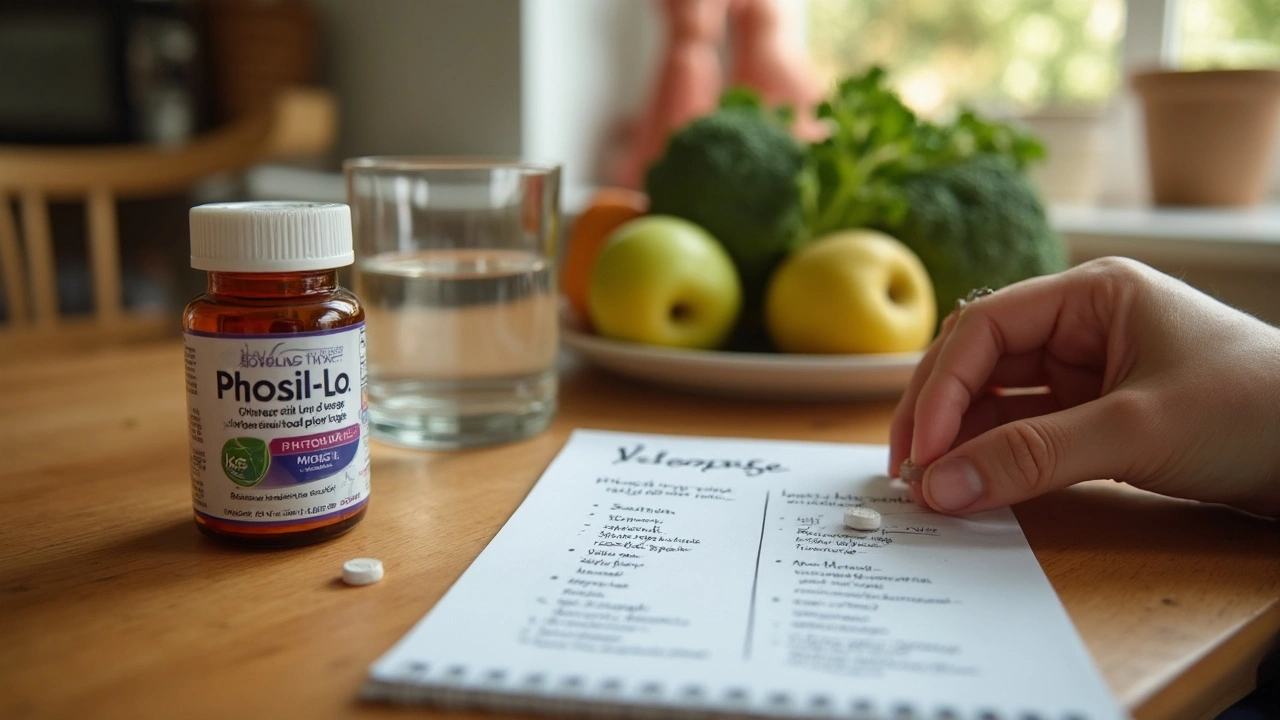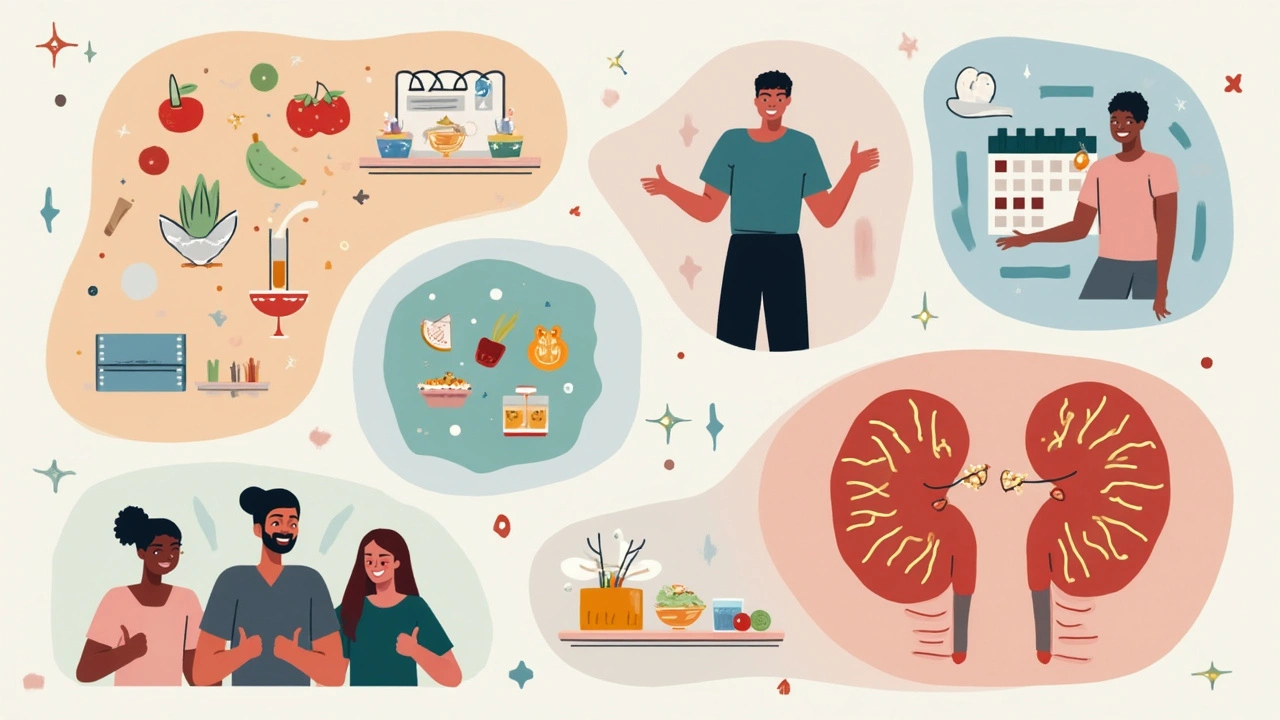You probably wouldn’t expect your dinner plate to create trouble for your bones, but if you live with chronic kidney disease, those tiny minerals hiding in your meals can turn into a big deal. Phosphorus is everywhere: in dairy, meats, nuts, sodas, and tons of processed food. People with healthy kidneys barely realize it—your body filters out extra phosphorus without a fuss. But with weakened kidneys, phosphorus starts to build up in your blood, quietly causing chaos with your bones, heart, and blood vessels. That’s where PhosLo steps in—a name you might have heard tossed around in clinics or support groups. It’s one of the most common ways doctors help keep those phosphorus levels under control when the kidneys can’t handle the job. But what is PhosLo really doing? And is it as simple as taking a little pill every day?
PhosLo: What It Does and Who It Helps
PhosLo isn’t some magic fix, but it packs a serious punch against a silent threat. Basically, it’s a phosphate binder—a fancy way of saying it grabs phosphorus in your gut so it never gets into your blood. The active ingredient, calcium acetate, hangs out in your stomach and intestines. Any phosphorus from food runs into it, sticks like glue, and the pair leave your body through, you know, the usual exit. Less phosphorus floating around in your blood means fewer risks to your bones and organs. Sounds like a win, right? Well, millions of people think so. In the US alone, about 786,000 folks are living with end-stage kidney disease and around 70% of them have issues with high phosphorus. That’s not a fringe problem.
PhosLo is usually prescribed to people who get dialysis. Their kidneys can’t clear phosphorus anymore, and diet changes alone often aren’t enough. Even with heroic willpower, you just can’t dodge all food forms of phosphorus. So, these folks take PhosLo with meals. Here’s a wild fact: the more phosphorus in your blood, the shorter your lifespan. Not meant to scare you, just the truth. A 2023 study from the American Society of Nephrology found that every 1 mg/dL increase in blood phosphorus bumped up risk of death by about 7% for people on dialysis. That turned heads in the medical world.
Doctors usually start PhosLo at a standard dose—two capsules (667 mg each) with every meal. It’s not a set-and-forget kind of thing, though. Your doctor will check your blood regularly and might tweak your dose. The goal is to keep blood phosphorus between 3.5–5.5 mg/dL for dialysis patients. There’s also a balance game here: since PhosLo is made with calcium, some people can end up with too much calcium in their blood. That’s where teamwork between you and your healthcare provider matters. It’s one of those meds you only take if you really need it—but if you do need it, skipping doses can lead to some brutal complications, like weakened bones (renal osteodystrophy), itchy skin, or even dangerous calcium-phosphorus buildup clogging arteries and heart valves.
It’s not just about the pill, either. PhosLo works best with certain eating habits. Lots of packaged foods sneak in phosphorus additives that your body absorbs better than what’s found naturally in foods. Frozen dinners, sodas, processed cheese? Phosphorus bombs. A good renal dietitian can show you where these traps hide—and, let’s be honest, it’s way easier to take your medicine right if you know exactly what you’re up against. But PhosLo steps in when you can’t fight the battle on food alone. That’s why it’s been a staple in nephrology for years.
| Group | Average Level (mg/dL) |
|---|---|
| PhosLo Users | 5.3 |
| Non-phosphate binder Users | 6.1 |
| All Dialysis Patients | 5.7 |

Side Effects, Steel Traps, and Safety Stuff
Anything that messes with minerals in your body is walking a tightrope. PhosLo has been studied for decades, so doctors know its quirks. For the vast majority, it causes no problems. The most frequent issue is stomach troubles: nausea, bloating, gas, or mild constipation. Not great, but usually manageable. Rarely, you’ll hear about people facing higher calcium levels than they should (hypercalcemia). That can trigger symptoms like muscle aches, fatigue, confusion—and, if ignored, more serious stuff like abnormal heart rhythms. If you’re on PhosLo, doctors usually check your blood calcium and phosphorus at least monthly, sometimes more.
You want a tough case? Some unlucky folks develop calcium deposits in their soft tissues—joints, skin, eyes—called calcifications. It’s not common, but when it happens, it’s nasty. The risk jumps if you take high doses or already have high calcium levels. That’s why PhosLo is hardly ever handed out to people with a history of calcium stones or certain other diseases. Sometimes, patients swap to non-calcium binders like sevelamer, but those can have their own problems and usually cost more.
Now, here’s a little-known twist: PhosLo can interact with other meds. If you’re popping iron supplements, some thyroid pills, or antibiotics like tetracyclines (not as common these days, but still around), spacing them out from your PhosLo dose is key—otherwise, absorption goes haywire. One big tip from pharmacists: leave about two hours between PhosLo and these other meds. Easier said than done, right? Juggling a handful of pills at different times is one of the biggest headaches people talk about in kidney support forums—or so you’ll hear if you hang out there.
Don’t forget about allergies. PhosLo contains gelatin, so if you’re vegan or have issues with pork or beef-derived capsules, mention it. There are chewable and liquid forms made for people who can’t swallow pills. Always check the label or ask your pharmacist if you’re not sure what’s in your version.
PhosLo is considered safe for adults (and older teens), but doctors almost never give it to little kids except in rare situations. Pregnant and breastfeeding women need a doctor’s okay to use it, since anything that changes mineral balance can affect a baby. If you’re one of the rare folks who gets kidney stones from calcium, PhosLo likely isn’t for you. People with hypercalcemia or certain parathyroid disorders may get sicker from it, not better. There are plenty of alternatives, and your healthcare team can walk you through all your options.
Worried about what to watch for at home? Here’s a quick checklist according to nephrology nurses and patient education sites:
- Stomach pain that sticks around or gets worse
- Unusual weakness, confusion, or sleepiness
- Tingling in hands, feet, or lips
- Very itchy skin that doesn’t stop
- Irregular heartbeat or muscle cramps
- Signs of an allergic reaction—rash, swelling, trouble breathing
If these pop up, get in touch with your clinic fast. Most issues are fixable, especially if you catch them early.

Real-Life Tips for Making PhosLo Work
Managing kidney disease gets overwhelming quickly. One month, you’re adjusting to the idea of dialysis, then you’re reading food labels to count out phosphorus, then you add meds like PhosLo to the mix. Life doesn’t pause for all this, either. Everyone wants tips that actually make things smoother, not just theoretical advice from a pamphlet.
First tip: timing is non-negotiable. If you forget to take PhosLo with your meal, it won’t help much to pop it 2 hours later. It’s got to be there in your gut right as the food arrives. Some patients set alarms on their phones, others keep a small pillbox in their lunch bag. People have even told me they tape sticky notes to the fridge or leave a capsule next to the salt shaker—whatever works, use it.
Nobody wants to chase down dozens of pills a day. If you take other phosphate binders or calcium supplements, ask your doctor if you can switch or simplify. Some renal dietitians recommend pairing PhosLo only with your biggest or highest-phosphorus meal, and using a different binder with smaller meals or snacks. That way, you reduce tablet overload. Just remember to loop your care team in before changing anything—mixing different binders without medical advice isn’t safe.
Hydration sounds basic, but it matters. PhosLo itself won’t dehydrate you, but dialysis often does. Patients who struggle with cramping, constipation, or that general “blah” feeling sometimes do better if they sip water regularly—within their fluid allowance, of course. There’s even data showing that mild dehydration can make phosphorus levels spike higher after meals. Small changes in routine can move the needle.
Let’s talk about food swaps. PhosLo helps, but it can’t replace smart eating. Instead of just cutting out everything fun, try these tactics:
- Pick fresh meats or fish over pre-cooked, breaded, or deli versions—they pack in less phosphorus
- Use herbs, pepper, and lemon for flavor instead of cheese-heavy seasonings
- If you love soda, check the label: colas often have phosphorus additives, but some lemon-lime sodas don’t
- Favor rice or regular pasta over instant versions, which can be loaded with phosphorus
- Ask your dietitian for a “white” bread rather than “whole grain”—most surprising, but it’s true
Keep your pharmacy in the loop if doctors change any of your prescriptions. Certain antibiotics, thyroid meds, or supplements should be separated from PhosLo by at least 2 hours to avoid absorption issues. Your pharmacist can help create a med schedule.
Now for a fact you rarely read: cost and coverage. Medicare Part D and most private insurance plans do cover PhosLo, but copays can add up. There are no major generic versions for the branded capsules, but talk to your doctor—some clinics have discount arrangements or patient assistance programs for those who qualify. A quick call can save real money, and no one should skip meds because of price alone. If your plan makes PhosLo unaffordable, ask about older, cheaper binders or alternative forms.
People on dialysis keep up with each other online now more than ever. The truth is, what works for one person might not work for another, but talking shop helps you know what questions to ask. Don’t ignore symptoms or side effects—if something feels off, mention it. Small tweaks, whether it’s timing, diet, or swapping your binder, can dramatically improve how you feel from day to day. And remember: controlling phosphorus isn’t just about feeling better today. It’s about protecting your bones, heart, and blood vessels for the long haul.
Quick recap for the note-takers: PhosLo is a phosphate binder, mostly for people on dialysis, that helps lower phosphorus in your blood, lowering the risk of bone and heart complications. Take it with meals, talk with your care team if you notice side effects, and pair it with smart food swaps. That’s the real playbook for getting the best out of PhosLo—science on your side and real-life routines that actually work. Stay sharp and use every trick in the playbook. Your future self will thank you.


Well, let me say this upfront: If you're relying on PhosLo without understanding the nuances of phosphate regulation in kidney disease, you're already behind the curve. 😊 This isn't just some run-of-the-mill phosphate binder. It's a delicate balance, folks.
Sure, PhosLo is widely used, but do you know the exact mechanisms? It binds dietary phosphate in the gut to reduce absorption. But guess what? Overuse can cause hypocalcemia, which ironically can exacerbate bone disease in kidney patients. So, don't just pop these like candy!
Also, side effects aren't always reported properly. GI issues? Very common. But some overlook vascular calcifications linked to phosphate imbalances. The article touches the surface, but there’s so much more depth required, I tell you.
Anyone here experienced trouble while on PhosLo? What regimes did your nephrologist recommend, and did dietary controls impact your outcomes better than medication alone? Share away.
Thanks for sharing that detailed viewpoint! PhosLo has definitely been a game changer for many dialysis patients we know, but as you said, it's not a silver bullet. The GI side effects are real and sometimes underestimated. 🤕
From my experience, combining PhosLo with strict dietary phosphate restriction yields better results than either approach alone. It's exhausting, but it truly helps to keep phosphate levels in check.
Also, the importance of regular lab monitoring can’t be stressed enough. It's easy to fall into a complacent routine and miss subtle shifts that could lead to complications.
Has anyone explored any natural dietary sources or supplements that might assist in phosphate control alongside PhosLo? We’ve been curious about that.
Clear and concise: PhosLo functions as a calcium acetate phosphate binder. Primarily, its role is to limit phosphate absorption, crucial in kidney disease management.
However, the calcium load should be considered, as excessive calcium may predispose to hypercalcemia, especially in patients with concurrent vitamin D therapy. Monitoring serum calcium and phosphate at regular intervals is mandatory to avoid complications.
Moreover, patient adherence must be emphasized; suboptimal compliance reduces treatment efficacy substantially.
I really don't care about the fancy details. If it helps and you need it, take it. End of story.
Everyone obsessing over side effects like it's the end of the world needs to get a grip. You think your grandma had the luxury to debate this stuff? No, she took what she was told and dealt with it. Stop overthinking.
Also, why are we nitpicking about diets? PhosLo is prescribed because the doctors know better. Just follow instructions, people.
Ah, the classic phosphate binder debate! I must say, the importance of correct punctuation in drug instructions cannot be overstated!!! It can literally save lives!!!
Many people underestimate just how finicky kidney patients must be with phosphate. Overphosphatemia leads to secondary hyperparathyroidism; thus, PhosLo isn’t merely a pill, it’s part of a larger therapeutic strategy!!!!
The article provides a good overview, but remember, consult your nephrologist before making any changes!!!
I get that PhosLo is effective but honestly, it feels like a band-aid rather than a solution. Dialysis patients already have so much to juggle. Taking yet another pill with potential side effects is tiring.
I wish there was more focus on improving overall kidney health to reduce dependence on phosphate binders.
Still, understanding how to manage side effects clearly is essential—for anyone prescribed PhosLo, keep your doc updated if you feel off.
I’m always skeptical about these meds, honestly. With PhosLo, I wonder about hidden agendas by pharmaceutical companies to keep kidney patients dependent forever.
There must be alternative ways to manage phosphate without risking calcium overload or other unseen side effects.
Does anyone else think this is more profit-driven than truly patient-centered?
Sure, tell me I'm paranoid, but with what I’ve seen in the industry, it’s hard not to question.
OMG, the drama about PhosLo is just wild!! Like, yes, it helps control phosphate, but people LOVE to make mountains out of molehills.
If you start obsessing about every little side effect, you’ll go crazy. Yes, sometimes stomach cramps happen, but come on, is that worth a meltdown?
Honestly, I've seen more people lose patience with the treatment than actually have serious problems with it.
Keep calm and take your meds, folks. It’s not rocket science! :D
Hey everyone! Just wanted to add that while managing phosphate with PhosLo, remember to stay hydrated and keep an eye on how your body feels. 😊
The GI side effects can be a real hassle, but some simple lifestyle tweaks can help ease them – smaller meals, avoiding greasy foods, and pacing your tablet intake with food.
Remember, it’s a marathon, not a sprint. Small wins count. Wishing everyone managing kidney health the best! 💪💖
In my practice, we emphasize a multidisciplinary approach to phosphate management. PhosLo is just one cog in the machinery of kidney care.
We focus on personalized diets, patient education, and regular biochemical monitoring to optimize outcomes.
Additionally, emerging therapies targeting FGF23 pathways herald hope for the future, potentially lessening the burden of binders like PhosLo.
We need to consider why phosphate control is critical to prevent secondary complications like cardiovascular calcifications.
The existential quandary of phosphate control beckons us towards a higher understanding. PhosLo is more than a pharmaceutical intervention; it is a symbol of our battle against the corporeal limitations imposed by renal insufficiency!!! Truly, its use, side effects, and patient adherence reflect the complex interplay between biomedical science and human persistence!!!
However, one must emphasize that a single solution is insufficient!!! It mandates an integrated approach involving dietetics, pharmacology, and patient empowerment!!!
Perchance, in future epochs, we will transcend such challenges altogether!!!